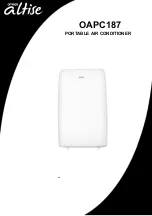
Coil Piping and Connections
60
UNT-SVX07E-EN
4. Vent the vacuum breaker line to atmosphere or
connect it into the return main at the discharge side of
the steam trap.
5. Pitch all steam supply and return mains down a
minimum of one inch per ten feet in the direction of
flow.
6. Do not drain the steam mains or take-off through the
coils. Drain the mains ahead of the coils through a
steam trap to the return line.
7.
Overhead returns require one psig of pressure at the
steam trap discharge for each two-feet elevation to
ensure continuous condensate removal.
8. Proper steam trap selection and installation is
necessary for satisfactory coil performance and
service life. For installation, use the following steps:
a. Position the steam trap discharge at least 12 inches
below the condensate return connection. This
provides sufficient hydrostatic head pressure to
overcome trap losses and ensure complete
condensate removal.
b. Trane recommends using flat and thermostatic
traps because of gravity drain and continuous
discharge operation.
c. Use float and thermostatic traps with atmospheric
pressure gravity condensate return, with automatic
controls or where the possibility of low pressure
supply steam exists.
d. Always install strainers as close as possible to the
trap inlet side. Reference
Figure 36
for an example
of a properly piped steam coil.
Figure 36.
Typical piping for steam coils
Table 22. Code of system components in piping diagram
FT
Float and thermostatic steam trap
BT
Bucket steam trap
GV
Gate valve
OV
Automatic two-position (on-off) control valve
TV
Automatic three-way control valve
VB
Vacuum breaker
CV
Check valve
ST
Strainer
AV
Automatic or manual air vent
Figure 37.
Main steam coil connection diagram
Full size of
coil connection
ST
GV
MV
Steam main
Pitch down
VB
GV
Airflow
12 in. min.
FT
ST
12 in. min.
Full
size
of
main
VB
GV
ST
FT
Return main
Full size of
steam trap
connection
ST
FT
v
ac
uum bre
a
ker (
if
des
i
red)
ste
a
m supply
plugged
c
ondens
a
te return
















































